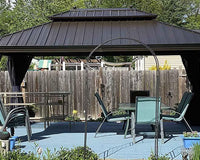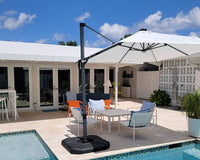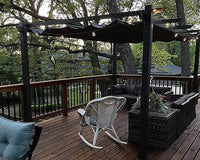Choosing the right outdoor bar stools can transform your patio or deck into an inviting entertainment space. With various materials available in the market, understanding their properties, durability, and maintenance requirements is crucial for making an informed decision. This guide will show different material options and choose the perfect outdoor bar stools for your space.
Factors to Consider When Choosing Outdoor Bar Stool Materials
Durability stands as the primary concern—your stools need to withstand constant exposure to sun, rain, temperature changes, and regular use. Weather resistance varies significantly among materials, with some offering natural protection while others require additional treatments or coatings.
Maintenance requirements should align with your lifestyle. Some materials need only occasional cleaning, while others demand regular sealing, polishing, or protective treatments. Consider how much time and effort you're willing to invest in upkeep before making your choice.
Comfort plays a vital role, especially for stools used frequently for entertaining. Consider factors like heat retention (metal can become hot in direct sunlight) and ergonomics. Style and aesthetics should complement your outdoor space while maintaining functionality. Some materials offer more color options and design flexibility than others.
Finally, weigh the initial cost against long-term value. Higher-priced materials often justify their cost through extended durability and reduced maintenance needs. Consider both your immediate budget and the total cost of ownership, including maintenance supplies and potential replacement timeframes.

Popular Materials for Outdoor Bar Stools
Wood
Natural hardwoods like teak and eucalyptus offer exceptional durability and classic appeal. Teak, while expensive, provides superior weather resistance and can last decades with proper care. Eucalyptus and acacia offer more budget-friendly alternatives with good durability. Regular sealing helps protect wood from moisture and UV damage.
Metal
Aluminum leads the metal category for outdoor furniture, offering excellent weather resistance without rust concerns. Powder-coated steel provides strength and style but requires more maintenance to prevent rust. Both options excel in windy conditions due to their weight.
Plastic/Resin
Modern high-density polyethylene (HDPE) materials offer outstanding weather resistance and minimal maintenance. These materials resist fading, cracking, and moisture damage while providing easy cleaning. Many manufacturers now offer recycled plastic options, combining durability with environmental consciousness.
Wicker/Rattan
Synthetic wicker dominates the outdoor market, offering the classic wicker look with superior weather resistance. Modern PE rattan withstands sun and rain while maintaining its appearance. Natural wicker, though charming, requires significant protection from the elements.
Upholstered Materials
Weather-resistant fabrics like Sunbrella provide comfort without sacrificing durability. Quick-dry foam prevents moisture retention, while UV-resistant materials maintain color integrity. Always choose marine-grade upholstery for optimal weather resistance.
Durability and Weather Resistance of Outdoor Bar Stool Materials
Here is how different materials perform in outdoor conditions, ranked from most to least durable. HDPE and aluminum lead in longevity, typically lasting 15-20 years with minimal maintenance. HDPE won't rust, fade, or crack, while quality aluminum resists corrosion naturally.

Teak follows closely, potentially lasting decades if properly maintained. Its natural oils provide excellent weather resistance, though the wood will patina to a silvery gray without regular sealing. Synthetic wicker and powder-coated steel offer 7-10 years of reliable service, provided they're well-maintained. However, steel may rust if its protective coating is compromised.
Climate significantly impacts material performance:
- Coastal Areas: Choose aluminum or HDPE to combat salt air.
- Hot, Sunny Regions: Look for UV-resistant materials; avoid dark metals that retain heat.
- Rainy Climates: Select materials with excellent moisture resistance, like HDPE or treated teak.
- High Wind Areas: Heavier materials like metal or solid teak perform better.
How to Style Your Outdoor Space with Bar Stools in 2025
For 2025, outdoor bar stool trends emphasize both aesthetics and functionality. When styling your space, start by considering your existing outdoor furniture and architecture. For contemporary homes, sleek aluminum or HDPE stools in modern finishes create a cohesive look. Traditional spaces pair well with teak or synthetic wicker options.
Color trends for 2025 favor earth tones like warm grays, rich browns, and subtle greens. However, don't be afraid to add personality through colorful cushions or powder-coated frames—these elements are easily changed if trends shift. Popular combinations include:
- Black frames with natural wood seats
- Bronze-finished metal with charcoal cushions
- All-weather wicker in driftwood gray
- White HDPE with navy blue accents
Consider scale when selecting stools—they should be proportional to your bar height and space size. For versatility, look for designs that can work with both bar-height and counter-height surfaces. Many homeowners are choosing swivel seats for added functionality and ease of use.
Maintenance and Care Tips for Different Outdoor Bar Stool Materials
Establish a regular cleaning routine based on your chosen material. HDPE requires simple soap and water cleaning, while metals benefit from periodic waxing to maintain the finish. Store cushions when not in use, and consider furniture covers for extended protection during severe weather.

Quick-action cleaning after spills prevents staining on all materials. For wood, annual sealing provides essential protection. Keep metal hardware tightened and lubricated for optimal performance.
Price Ranges for Outdoor Bar Stool Materials
Understanding price points helps budget effectively for outdoor bar stools while considering long-term value. Here's a practical breakdown by material:
Entry-Level Options ($100-200 per stool)
- Basic powder-coated steel
- Standard HDPE
- Synthetic wicker with a steel frame
- Basic aluminum designs
Mid-Range Choices ($200-400 per stool)
- Premium HDPE with enhanced features
- Quality aluminum with superior finishes
- Commercial-grade synthetic wicker
- Eucalyptus wood
- Better upholstered options with weather-resistant fabrics
High-End Selections ($400-800+ per stool)
- Grade-A teak
- Designer metals with premium finishes
- Custom HDPE colors and styles
- Premium mixed-material designs
Consider these long-term value factors
- HDPE might cost more initially but requires virtually no maintenance
- Teak's high price is offset by its multi-decade lifespan
- Lower-priced options often need replacement sooner
- Factor in maintenance costs (sealers, covers, cleaning supplies) when comparing prices
Choosing the Right Outdoor Bar Stools
Selecting the right material for your outdoor bar stools depends on balancing durability, maintenance requirements, style, and budget. For maximum longevity and minimal maintenance, HDPE and aluminum stand out as top choices. Consider your climate and usage patterns when making your final decision.
FAQ
What material lasts the longest outdoors?
HDPE and aluminum are the most durable, potentially lasting 15-20 years with minimal maintenance.
Which requires the least maintenance?
HDPE requires simple soap and water cleaning, making it the low-maintenance option.
Are wooden stools good for coastal areas?
Teak and other treated woods perform well in coastal areas, but aluminum or HDPE are better choices to combat salt air.
How often should I replace outdoor cushions?
Replace cushions as needed, especially if they show signs of fading, mildew, or deterioration.
Can I leave my stools outside year-round?
Yes, as long as you choose weather-resistant materials like HDPE, aluminum, or treated woods and properly maintain them.




